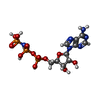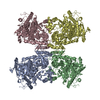+Search query
-Structure paper
| Title | Structural basis for Polθ-helicase DNA binding and microhomology-mediated end-joining. |
|---|---|
| Journal, issue, pages | Nat Commun, Vol. 16, Issue 1, Page 3725, Year 2025 |
| Publish date | Apr 19, 2025 |
 Authors Authors | Fumiaki Ito / Ziyuan Li / Leonid Minakhin / Htet A Khant / Richard T Pomerantz / Xiaojiang S Chen /  |
| PubMed Abstract | DNA double-strand breaks (DSBs) present a critical threat to genomic integrity, often precipitating genomic instability and oncogenesis. Repair of DSBs predominantly occurs through homologous ...DNA double-strand breaks (DSBs) present a critical threat to genomic integrity, often precipitating genomic instability and oncogenesis. Repair of DSBs predominantly occurs through homologous recombination (HR) and non-homologous end joining (NHEJ). In HR-deficient cells, DNA polymerase theta (Polθ) becomes critical for DSB repair via microhomology-mediated end joining (MMEJ), also termed theta-mediated end joining (TMEJ). Thus, Polθ is synthetically lethal with BRCA1/2 and other HR factors, underscoring its potential as a therapeutic target in HR-deficient cancers. However, the molecular mechanisms governing Polθ-mediated MMEJ remain poorly understood. Here we present a series of cryo-electron microscopy structures of the Polθ helicase domain (Polθ-hel) in complex with DNA containing different 3'-ssDNA overhangs. The structures reveal the sequential conformations adopted by Polθ-hel during the critical phases of DNA binding, microhomology searching, and microhomology annealing. The stepwise conformational changes within the Polθ-hel subdomains and its functional dimeric state are pivotal for aligning the 3'-ssDNA overhangs, facilitating the microhomology search and subsequent annealing necessary for DSB repair via MMEJ. Our findings illustrate the essential molecular switches within Polθ-hel that orchestrate the MMEJ process in DSB repair, laying the groundwork for the development of targeted therapies against the Polθ-hel. |
 External links External links |  Nat Commun / Nat Commun /  PubMed:40253368 / PubMed:40253368 /  PubMed Central PubMed Central |
| Methods | EM (single particle) |
| Resolution | 3.1 - 3.8 Å |
| Structure data | EMDB-43706, PDB-8w0a: EMDB-43816, PDB-9asj: EMDB-43817, PDB-9ask: EMDB-43818, PDB-9asl:  EMDB-45217: Human DNA polymerase theta helicase domain in microhomology annealed state 1, dimer form EMDB-45218, PDB-9c5q: |
| Chemicals |  ChemComp-ANP: |
| Source |
|
 Keywords Keywords | TRANSFERASE/DNA / DNA repair / helicase / ATPase / TRANSFERASE-DNA complex / TRANSFERASE / DNA BINDING PROTEIN |
 Movie
Movie Controller
Controller Structure viewers
Structure viewers About Yorodumi Papers
About Yorodumi Papers













 homo sapiens (human)
homo sapiens (human)